A History of the County of Berkshire: Volume 4. Originally published by Victoria County History, London, 1924.
This free content was digitised by double rekeying. All rights reserved.
'Parishes: Speen', in A History of the County of Berkshire: Volume 4, ed. William Page, P H Ditchfield (London, 1924), British History Online https://prod.british-history.ac.uk/vch/berks/vol4/pp97-110 [accessed 31 January 2025].
'Parishes: Speen', in A History of the County of Berkshire: Volume 4. Edited by William Page, P H Ditchfield (London, 1924), British History Online, accessed January 31, 2025, https://prod.british-history.ac.uk/vch/berks/vol4/pp97-110.
"Parishes: Speen". A History of the County of Berkshire: Volume 4. Ed. William Page, P H Ditchfield (London, 1924), British History Online. Web. 31 January 2025. https://prod.british-history.ac.uk/vch/berks/vol4/pp97-110.
In this section
SPEEN with SPEENHAMLAND, BAGNOR and BENHAM
Spinae (iv cent.); Spene (ix–xvii cent.); Spone, Speinis (xi cent.); Spenes (xii–xiv cent.); Spienes, Spines (xiii cent.); Speyne (xiv cent.).
The parish of Speen lies between the Rivers Kennet and Lambourn, though one of its tithings, Bagnor, lies north of the latter river.
The parish consists of several townships or tithings: the township of Speen, which since the Conquest has been divided into three tithings; the township of Bagnor (Bagenore, xi–xiv cent.; Badgenor, xvi cent.), and the township of Benham or Marsh Benham (Bennanhamme, Bennaham, x cent.; Byenham, xv cent.), which is the greater part of the vill of Benham, and lies in the hundred of Kintbury Eagle. The ecclesiastical parish of St. Mary, Speenhamland, comprising a part of Wood Speen, was formed in 1844, and the ecclesiastical parish of Stockcross, consisting of Marsh Benham and a few acres of Church Speen, in 1854. (fn. 1)
The village of Speen lies on the ridge dividing the valleys of the Kennet and Lambourn, and adjoins the borough of Newbury, within which the tithing of Speenhamland and parts of Wood Speen and Church Speen are now included. Wood Speen is a long, narrow strip of land adjoining the River Lambourn, and the houses are in clusters near either end, those at the east being included within the borough boundaries. The village of Marsh Benham lies in the valley of the Kennet, not far from the western boundary, while the village of Stockcross, which seems to have grown up on the waste during the last two centuries, lies on the ridge, in the corner of the township of Benham, and is partly in the tithing of Church Speen. There is a Wesleyan chapel here. Bagnor lies on the north side of the Lambourn River, where it is joined by the Winterbourne stream.
The land rises from 245 ft. above the ordnance datum on the south-east of the parish to 469 ft. on the north-west boundary. The parish contains 3,862 acres, of which 1,072½ are arable, 1,520¼permanent pasture and 671 woods and plantations. (fn. 2) The chief crops are wheat, barley and oats. The soil is very varied, being chalky on the lower slopes and clay above, with gravel on the plateau; in the valley bottoms there are gravel and alluvium and peat in the Kennet Valley. An account of the peat was written in 1756 by John Collet, M.D. (fn. 3)
The road from London to Bath traverses the whole length of the parish from east to west, and from it branch off roads to Hampstead Norris, Oxford, Lambourn and Baydon.
The Great Western railway from Reading to Devizes, opened 21 December 1847, crosses the extreme south of the parish, but without a station here, while the Lambourn Valley branch of the same company, opened in 1898, passes through the parish, with a station near the village and another between Bagnor and Stockcross.
Speen Moor was inclosed by an Act passed in 1737, and the common fields in the rest of the parish, except the tithing of Bagnor, were allotted under an Act of 1779. (fn. 4) Copies of the awards are in the custody of the parish council.
The population of the rural part is largely agricultural, but the proximity of the parish to the town of Newbury has caused many artisans to live here, and the occupations of the urban portion of the population are very varied. There was a silk factory near Shaw Crescent early in the 19th century. (fn. 5)
Benham Place, recently called Benham Valence, is the seat of Sir Richard Sutton, bart., Speen House is the residence of the Rev. J. Lomax Gibbs, and there are many other houses of considerable size in the parish.
There is a well about 200 yards above the church, called 'Our Lady's Well,' whose waters are supposed to possess certain healing qualities. (fn. 6) In a 17thcentury conveyance there is mention of 'Weeping Cross closes, near the Weeping Cross, in the parish of Speen. (fn. 7)
In 1825 a skull, together with flint implements, was found in the peat at Benham Marsh, and in 1830 another skull was found there, opposite to Benham House. (fn. 8) A dug-out canoe was found at Bagnor. (fn. 9)
Early in the 18th century a large cinerary urn of Bronze Age type was dug up on Speen Moor, about 8 ft. or 10 ft. from the river. It appears to have been buried in a round barrow, which was destroyed at the time of its discovery by the peat diggers. (fn. 10)
In 1825 a bronze spear-head, about 7 in. long and 1½ in. wide, with two holes at the base of the blade, was found under Speen Hill, and the following year another was found 10¼in. long and 2¾ in. wide, (fn. 11) elsewhere said to be 9 in. long. (fn. 12) Part of a human skull was found about 1839 in the same meadow. (fn. 13) A bronze palstave was found in 1894 at Bagnor. (fn. 14)
All authorities are now agreed that the name of Speen represents the Roman Spinae, but the scarcity of remains of this period within the bounds of the parish has led some archaeologists to believe that the Roman station grew up on the gravel plateau on the other side of the river. (fn. 15) A few objects of the Roman period have been found, though in many cases the description that has survived is vague and unsatisfactory.
The second battle of Newbury was fought partly in this parish, and a wing of the Parliamentary forces, under Waller, was stationed upon Speen Hill. (fn. 16)
During the latter part of the 17th century Speenhamland grew to be an important suburb of Newbury, as the main road from London to Bath traversed it and avoided the rest of the town. Numerous coaching inns arose by the side of this road, of which the 'Bear,' the 'King's Arms,' the 'Chequers' and the 'Pelican' were the most important. It was at one of these inns, the 'Pelican,' that on 6 May 1795 the magistrates of Berkshire met and settled the scale of relief to be given to the poor, which was afterwards known as the Speenhamland Act, the action of the Berkshire magistrates being imitated all over England. (fn. 17)
In 1825 an Act was passed for improving the highways within the borough of Newbury and the tithing or hamlet of Speenhamland, and in 1878, by the Newbury Borough Extension Act, Speenhamland and certain portions of Church Speen and Wood Speen were included in the borough of Newbury. (fn. 18)
The following interesting place-names have been found:—'Deyes,' (fn. 19) 'Wyvorne,' (fn. 20) Wycroft, Eldeland, Sortehwet Lande, Pincheslad (early xiii cent.) (fn. 21); Hedehulf, Queenshows, Ukkefordysmede (1476) (fn. 22); 'a croft called Sytehull' (fn. 23) and 'the sign of the "Bear" in Speenhamland. (fn. 24)
Sir George Allan Madden, major-general in the British and Portuguese armies, lived with the Margrave and Margravine of Anspach at Benham Place from 1804 to 4 July 1805, when at the Margrave's instance he was appointed inspecting field officer of yeomanry, cavalry and volunteers for the Midland district, with local rank of lieutenant-colonel. (fn. 25)
Charles Edward Long, the genealogist and antiquary, was born at Benham Place 28 July 1796. (fn. 26)
Manors
By a forged charter of Kenulf, King of Mercia, the entire wood which is called Speen (fn. 27) was confirmed to the abbey of Abingdon.
SPEEN was held in the reign of Edward the Confessor by Carlo of the king, and in 1086 by Humphrey Vis de Lou, also of the king. (fn. 28) Between these dates it seems to have been held by Bernard son of Geoffrey de Neufmarché, who about 1079 gave the church of Speen to St. Mary of Aufay. (fn. 29) Humphrey or his immediate successor apparently lost this manor, as he did Benham (fn. 30) (q.v.), for in 1166–7 Bernard's grandson, William de Braose, rendered I mark on account of this manor. (fn. 31) In the 13th century the overlordship was held by William de Braose as part of his honour of Brecknock, and passed to Humphrey de Bohun, who married Braose's daughter Eleanor. (fn. 32) It probably remained in the family of the Bohuns, and passed to the Staffords, coming to the Crown on the attainder of the Duke of Buckingham, but no reference has been found to show that the Bohuns or Staffords claimed the overlordship of Speen after the middle of the 13th century.
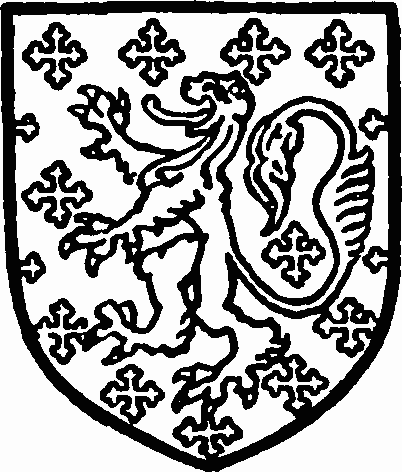
Braose. Azure crusilly a lion or.
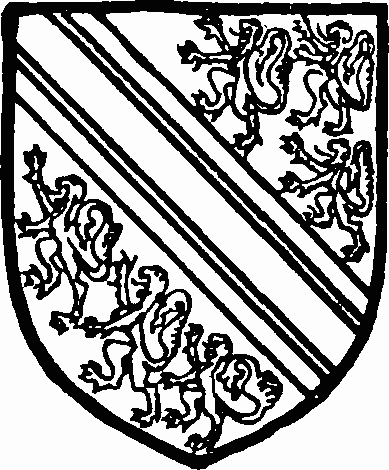
Bohun. Azure a bend argent between two cotises and six lions or.
It seems that early in the 13th century the manor was granted to William Marshal, first Earl of Pembroke, for in 1218 he had licence to hold a weekly market at Speen on Mondays, provided it was not to the detriment of the merchants there. (fn. 33) William Marshal died in May 1219, and the manor presumably passed to his eldest son William. He died in April 1231 and was succeeded in the title by his brother Richard, though there are reasons for believing that this manor was held, for a year at least, by the king. Richard died, also without issue, on 16 April 1234, and was succeeded by his next brother Gilbert, who was killed in a tournament on 27 June 1241, leaving no children. Walter the next brother succeeded him, and is returned as holding the manor, (fn. 34) but he died childless on 24 November 1245 seised of the manor of Speen and lands and tenements in Speenhamland and Wood Speen. (fn. 35) His brother Anselm succeeded him, but died on 5 December 1245, also childless, before he had done homage for the manor. Meanwhile Eleanor, the widow of William the eldest brother, held a considerable amount of the land and rents as dower.
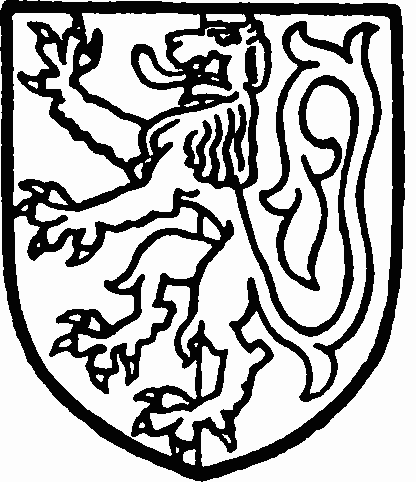
Marshal. Party or and vert a lion gules.
At the death of Anselm the manor and rents were divided among his sisters and their heirs. The manor itself went to the eldest sister, Maud Countess of Surrey and widow of Hugh Bigod, third Earl of Norfolk, (fn. 36) but considerable lands and rents fell to the share of the other co-heirs: the heirs of Joan wife of Warine de Monchensey, of Isabel wife of Gilbert de Clare Earl of Hertford and Gloucester, of Sybil wife of William de Ferrers Earl of Derby, and of Eva wife of William de Braose, Lord of Brecon and Abergavenny. Several of these heirs obtained additional lands in 1275, on the death of William Marshal's widow Eleanor Countess of Leicester, and each of these shares is subsequently described as a manor. (fn. 37)
The Countess of Surrey's original manor passed to her son Roger Bigod, fourth Earl of Norfolk, who died childless on 4 July 1270 seised of the manor of Hampstead Marshall with its grange of Speen, held of the king in chief by service of the marshal's rod. (fn. 38) At his death the manor seems to have come into the hands of the king, (fn. 39) but soon passed to Bigod's nephew Roger Bigod Earl of Norfolk, who received as his share at the death of William Marshal's widow the Countess of Leicester lands and rents in Newbury to the value of £5 6s. 2d. (fn. 40) He is returned as having free warren here in 1275–6, as well as gallows and assize of bread and ale. (fn. 41) His manor seems to have been taken into the king's hands in 1277, (fn. 42) but he was holding it in 1278–9. (fn. 43)
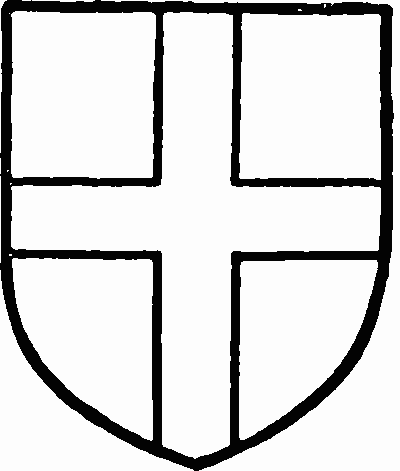
Bigod. Or a cross gules.
In 1279, by way of settling a dispute with William de Valence, another of the co-heirs, Roger Bigod granted to William £50 yearly of land here, (fn. 44) and it seems probable that with this grant went most that was valuable in the manor. Roger was still, however, nominally holding the manor in 1306, (fn. 45) and died childless on 11 December in that year, when under a surrender of 1302 his honours and lands passed to the king. (fn. 46)
William de Valence Earl of Pembroke died in 1296, and the manor descended to his son Aymer de Valence Earl of Pembroke, (fn. 47) who died childless in 1324. (fn. 48) The manor then passed to John son of his sister Isabel wife of John Hastings Lord Hastings and Abergavenny. He died a few months later, when the manor descended to his son Lawrence, then a minor (fn. 49) in the custody of the Bishop of Worcester. (fn. 50) In 1339 there was a dispute between Lawrence and the bishop as to the possession of the lands, (fn. 51) and in October of that year Lawrence had licence to enfeoff Sir Thomas West of the manor. (fn. 52) In 1341 it was decided that the bishop was entitled to the profits up to 5 May 1341, when Lawrence proved himself to be of full age. (fn. 53)

Valence. Burelly argent and azure an orle of martlets gules.
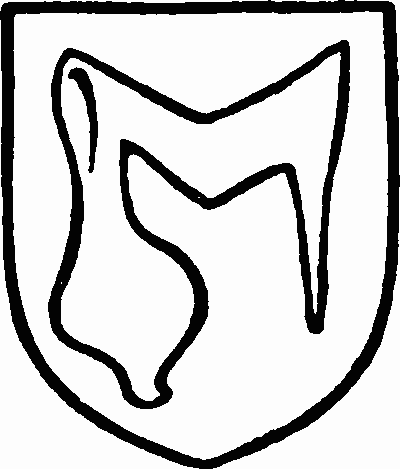
Hastings. Argenta sleeve sable.
Lawrence, who was created Earl of Pembroke, died in 1348, when the manor passed to William Hastings, surnamed le Neveu, an illegitimate son. (fn. 54) He had already held the manor before Lawrence's death, for on 28 October 1347, (fn. 55) when about to start for foreign parts, he granted the manor to Robert de Eleford and Theobald de Mounteney, on condition that if he died abroad they should pay his debts and found a chantry for his soul. He returned shortly afterwards, and died on 9 March 1349. (fn. 56) Robert and Theobald seem then to have seized the manor, but were dispossessed, as it had been alienated without licence, (fn. 57) and William was a bastard and had no heirs. (fn. 58) On 3 June 1350, however, it was restored to them. (fn. 59)
Agnes, widow of Lawrence Earl of Pembroke, who had married as her second husband John Hakelut, (fn. 60) died 25 July 1368 seised of dower in the manor, when her heir was her son John Earl of Pembroke. (fn. 61) He seems to have granted these lands to Walter Amyas, John Abraham and others to hold in trust for his wife Anne, and died in 1375. At Anne's death the king seized the estate as guardian of the infant heir. This heir, John last Earl of Pembroke, died under age on 30 December 1389. (fn. 62)
From an inquisition taken on 31 May 1399 (fn. 63) it would seem that Robert de Eleford and Theobald de Mounteney did not succeed in obtaining possession of the manor, but that it was granted by King Richard II to Ingram, lord of Couci, who had married Isabel the king's aunt. Ingram granted it for life to Henry Alemayn and Agnes his wife, (fn. 64) and on 5 October 1397 the king granted the reversion in fee to John Champ and Joan his wife. This grant was confirmed by Henry IV on 14 October 1399. (fn. 65) In 1437–8 John Champ and others sold the reversion of the manor, now called CHURCH SPEEN, to Reginald West and others, (fn. 66) and died on 14 February 1440 seised of the manor, held of the king as onethirtieth of one-fiftieth of a knight's fee. (fn. 67) Reginald West Lord de la Warr and his co-trustees had licence on 11 February 1445 to sell the manor to John Roger the younger and his trustees. (fn. 68)
John Roger had already purchased the adjoining manor of Benham Valence, and for a time this manor passed with the manor of Benham Valence (q.v.). When in 1543 Church Speen came by exchange into the hands of the king it was attached to the royal manor of Donnington, (fn. 69) and Thomas Cawarden, a groom of the Privy Chamber, was made steward and bailiff here, (fn. 70) while in 1545 the manor was leased to him for twenty-one years. (fn. 71) Soon after the expiration of this lease Queen Elizabeth, in 1567–8, granted the site of the manor to Thomas Henneage and Anne his wife, and the heirs of Thomas, to hold of the queen in chief, (fn. 72) and they in the autumn of 1568 sold the manor to Thomas Dolman, sen., and Thomas Dolman, jun., (fn. 73) lords of the manor of Shaw.
Church Speen then followed the descent of the manor of Shaw (q.v.) until in 1784 Sir Joseph Andrews, bart., and Elizabeth his wife sold it to William Brummell and Joseph White. (fn. 74) After the death of Brummell the manor was sold to John Bebb of Donnington Grove, and after the death of his widow was purchased from her heirs by Charles Hopkinson, whose sons Aurelius Arthur, Charles Caesar and George Henry were joint owners of the manor in 1892. (fn. 75)
With regard to the shares of the other heirs of William Marshal Earl of Pembroke, that of Isabel the wife of Gilbert de Clare Earl of Hertford and Gloucester seems to have passed after the death of Anselm Earl of Pembroke, in 1245, to their son Richard, and after his death, on 15 July 1262, to his son Gilbert de Clare, surnamed the Red. It was at this time known as the manor of SPEENHAMLAND (fn. 76) and followed the descent of the earldom of Hertford till 1312, when Gilbert Earl of Hertford made a grant for life of a yearly rent of £8, issuing from this manor, to his half-sister Isabel, which was confirmed in 1314, and, after his death in the same year, by the king in 1315. (fn. 77) In 1315–16 Isabel de Clare was returned as lady of the manor. (fn. 78) Later on she married Maurice de Berkeley. At her death on 7 July 1333 it reverted to the heirs of her brother Gilbert, whose only child John died young during his father's lifetime, and his heir was his sister Eleanor the wife of Hugh le Despenser. The manor descended with the barony of Despenser till 1400, when Thomas le Despenser Earl of Gloucester was beheaded and all his lands forfeited. (fn. 79)
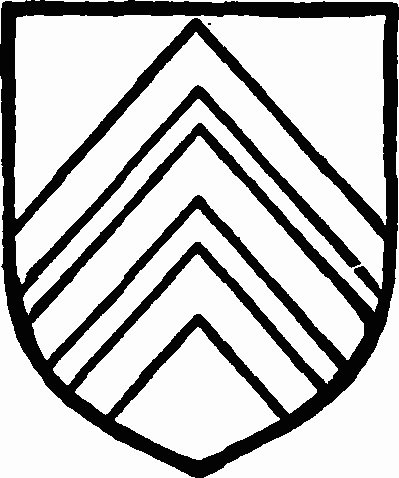
Clare. Or three cheverons gules.
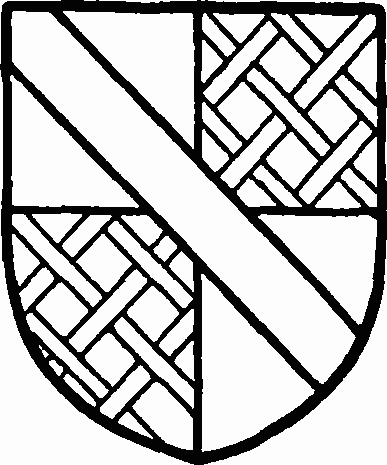
Despenser. Argent quartered with gules fretty or with a bend sable over all.
The manor of Speenhamland, however, passed to his daughter Isabel, who married firstly Richard Beauchamp Lord Bergavenny, created Earl of Worcester, and after his death in 1422 Richard Beauchamp Earl of Warwick. She died on 26 December 1439 seised of this manor, when her heir was her son Henry Earl of Warwick, then aged fifteen. (fn. 80) Henry was created Duke of Warwick and died on 11 June 1446 seised of land here, when his heir was his daughter Anne Countess of Warwick, aged two years. (fn. 81) She died on 3 January 1448–9. (fn. 82)
At the death of Anne one of her co-heirs was the heir of her grandmother Isabel, who was George Nevill Lord Bergavenny, son of Edward Nevill Lord Bergavenny and Elizabeth only daughter of Isabel by her first husband Richard Beauchamp Lord Bergavenny and Earl of Worcester. (fn. 83) George died on 20 September 1492, when the manor seems to have passed to his son George Lord Bergavenny, who with Margaret his second wife sold it in 1513 to Thomas Lathom, clerk, and others, (fn. 84) apparently in trust for Sir Thomas Englefield.
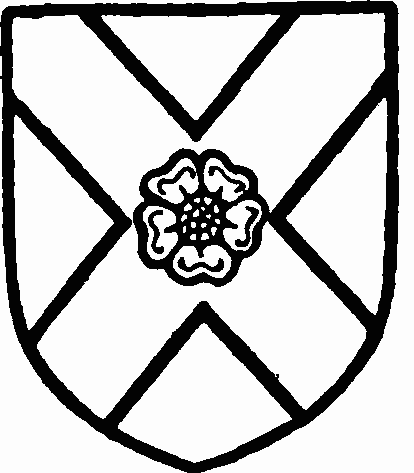
Nevill of Bergavenny. Gules a saltire argent charged with a rose gules.
Sir Thomas Englefield died on 3 April 1514 seised of the manor of Speenhamland, bought of George Lord Bergavenny, when his heir was his son Thomas, then aged twenty-six. (fn. 85) Thomas was knighted in 1501, (fn. 86) and died before 29 March 1538, when his heir was his son Francis, (fn. 87) who was afterwards knighted, but attainted in 1586, when the manor came to the Crown. It was granted in 1588–9 to Thomas Crompton and others, (fn. 88) after which for a time the history of this manor is obscure, but it seems probable that this was the manor described as 'messuages and lands in Speen,' which were sold in 1622–3 by Thomas Earl of Kelly to Sir Peter Vanlore and Sir William Rolfe, (fn. 89) apparently in trust for the former.
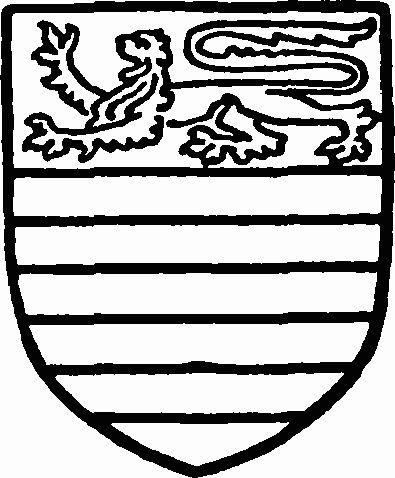
Englefield. Barry gules and argent and a chief or with a lion passant azure therein.
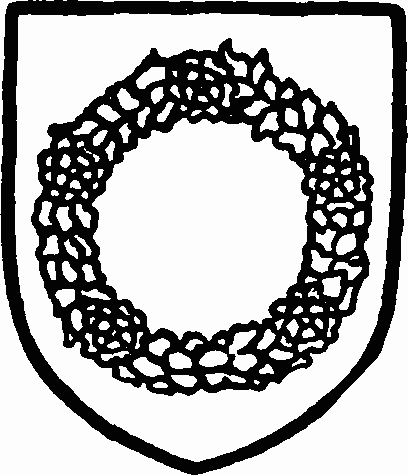
Vanlore. Or a garland in its proper colours.
Sir Peter Vanlore was born at Utrecht and married Jacoba daughter of Henry Teighbott, who bore him a son and nine daughters. He became a London merchant, was naturalized in 1607, knighted by James I and acquired large estates in Gloucestershire. He died on 6 December 1627 at the age of eighty seised of the manor of Speen or Speenhamland, (fn. 90) when under a settlement of 28 July in that year the manor was divided into five shares among his son Peter, then aged thirty, his second daughter Elizabeth wife of John Vanderbende, his third daughter Mary wife of Sir Edward Powell, his fourth daughter Anne wife of Sir Charles Adelmare alias Caesar, and his fifth daughter Catherine wife of Sir Thomas Glemham.
His son Peter was created a baronet on 3 October 1628 and married Susanna daughter of Lawrence Becke of Antwerp. He died without male issue in 1644–5, leaving his share divided equally among his three daughters, Jacoba wife of Henry Zinzan alias Alexander, Susan wife of Sir Robert Croke, kt., and Mary wife of Henry Alexander third Earl of Stirling. (fn. 91)
In 1650 Sir Robert Croke and Susan sold their share to William Burnett and William Satterthwaite (fn. 92); in 1651 Mary widow of the Earl of Stirling sold hers to James Alexander and James Davenport (fn. 93); and in 1653 Henry Zinzan and Jacoba sold theirs to George Butterwick and John Libb. (fn. 94)
Mary the third daughter of the first Sir Peter, with her husband Sir Edward Powell, conveyed property described as the manor of Speenhamland in 1651 to Anthony Bassett, (fn. 95) who soon afterwards conveyed it to Thomas and Anne Levingstone, (fn. 96) but this appears to have been a life interest in one-fifth part only, for after her death without issue her share was divided into four parts among the heirs of her brother and three surviving sisters. In 1662 the three heirs of the second Sir Peter conveyed their shares of Lady Powell's portion to William Burnett and William Satterthwaite. (fn. 97) Henry Zinzan and his wife, however, afterwards conveyed their share of their aunt's portion in 1665 to William Yorke and Henry Kempe. (fn. 98) Anne, the wife of Sir Charles Adelmare alias Caesar, who inherited another fifth share, had two daughters, Jacomina wife of Sir Henry Anderson of Penley, Herts., and Anne wife of Thomas Levingstone of Micheldever, Hants, (fn. 99) besides a son Henry. She died on 13 June 1625, and at the death of her husband on 6 October 1643 her share was divided between the two daughters. In 1644 and again in 1646 Anne and Thomas Levingstone conveyed their share to Nevill Cradock, (fn. 100) apparently in trust, for they sold it in 1656 and 1660 to Constantine Skinner, merchant. (fn. 101) After the death of Jacomina her share passed to Sir Richard Anderson, and about 1662 the share of Mary Lady Powell passed to Sir Richard, Sir Henry Caesar and the Levingstones, who jointly sold it in 1663 to Alexander Lockhart. (fn. 102) Thomas and Anne Levingstone seem to have inherited Sir Richard's share a few years later, for they sold another tenth part of the manor in 1667 to John Curteis. (fn. 103)
Catherine Glemham's share seems to have passed to her two sons Sackville and Peter. Sackville conveyed his share in 1656 to Robert Maryott and others, (fn. 104) who sold it in 1657 to Joseph Stevens and Alexander Blagrave. (fn. 105) Peter was holding his share in 1656, (fn. 106) but at his death it seems to have gone to his two co-heirs, one of whom was Elizabeth the daughter of his brother Henry, who married Sir Thomas Cressy of Frilsby, Lincolnshire. In 1658 she sold this share to John Seddon, (fn. 107) and on inheriting Lady Powell's share Sir Thomas, with his daughter Anne and her husband Thomas Parkyns, sold it in 1662 to Richard Sydenham and David Slater. (fn. 108)
The share of Elizabeth and John Vanderbende seems to have passed to their son Abraham, who placed his share of the manor in settlement in 1656, in favour of himself and his son John. (fn. 109) He seems to have bought up some, if not all, of the other shares, for in 1685, with Mary his wife and his son John, he placed the manor of Speenhamland in settlement. (fn. 110) He died before 1695, when John, with Mary his mother, sold the manor to Thomas Dolman, (fn. 111) who held the adjoining manor of Shaw (q.v.). It continued to pass with that manor and is now the property of the hon. Mrs. Farquhar.
A so-called manor of SPEENHAMLAND was in 1535–6 placed in settlement by William Stafford of Bradfield and his wife Anne (fn. 112) daughter of Sir John Langford. (fn. 113) In 1571 Thomas, possibly the son of William Stafford, settled lands in Speenhamland (fn. 114) in favour of his younger sons and daughters. He died on 4 April 1584 seised of the manor of Speenhamland, (fn. 115) when in spite of the settlement the manor seems to have passed to his eldest son Read, then aged forty-two. Sir Read Stafford, who had been knighted in 1601, died on 16 June 1605 seised of the manor of Speenhamland, leaving a nephew Edward, son of his brother Edward, aged twelve, his heir. (fn. 116) Edward Stafford was holding the manors of Stanford and Speenhamland in 1613, (fn. 117) after which the history of the manor is obscure, but it seems possible that this manor, described as messuages, lands, view of frankpledge, &c., in Speen, was sold by the Rev. Nathaniel Wright of Englefield and Anne his wife in 1712 to John Iwells and Thomas Browne. (fn. 118)
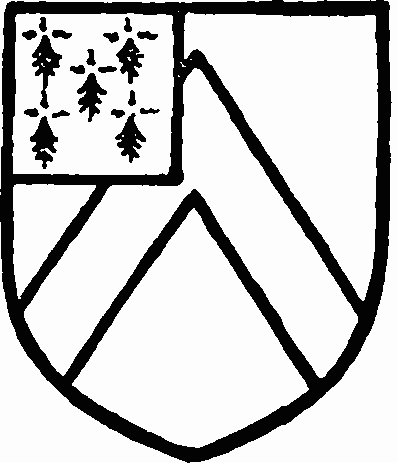
Stafford. Or a cheveron gules and a quarter ermine.
Of the remaining two sisters of the Earls of Pembroke, the heirs of Sybil, who married William Ferrers Earl of Derby, received their share elsewhere, but the heirs of the last sister Eva, who married William de Braose, Lord of Brecon and Abergavenny, received lands and rents in this parish. These heirs were Isabel, married firstly to David son of Llewelyn Prince of Wales and afterwards to Peter son of Herbert, Maud wife of Roger Lord Mortimer of Wigmore, Eva wife of William Cauntlow, and Eleanor wife of Humphrey de Bohun. Of these the heirs of Isabel seem to have obtained their share elsewhere, but certain lands and rents in Newbury, Speenhamland and Wood Speen were divided in 1275 among the three other daughters or their representatives, Roger and Maud de Mortimer, Humphrey de Bohun and Eudo la Zouch, who had married Melisent, one daughter, and John de Hastings, son of Henry Lord Hastings, who married Joan, the other daughter of Eva and William Cauntlow. (fn. 119) Of these shares that of John Hastings was added to his manor of Church Speen, and the Mortimer share was held by Maud as late as 1296–7. (fn. 120) The other shares were too small to deserve further notice.
SPEEN BASSET or WOOD SPEEN.—Early in the 13th century William Marshal Earl of Pembroke, probably the younger of that name, enfeoffed Thomas Basset, apparently the fourth son of Alan Basset of Wycombe and Alice daughter of Stephen de Gray, of £10 worth of land in his manor of Speen. (fn. 121) On his death the manor passed to his elder brother Fulk, Bishop of London, (fn. 122) and after his death to another brother Philip Basset, (fn. 123) lord chief justice, who died in 1271. Ela his widow retained this manor in dower, (fn. 124) and was apparently holding it in 1275–6. (fn. 125) At her death it passed to Aline, Philip's only daughter by his first wife, who married firstly Hugh le Despenser, lord chief justice, and secondly Roger Bigod Earl of Norfolk. She died in 1280–1, when the manor passed to her son Hugh le Despenser, then aged twenty. (fn. 126) Hugh had a grant of free warren here in 1300, (fn. 127) and was holding the manor in 1315–16. (fn. 128) He was created Earl of Winchester in 1322 and was holding this manor that year (fn. 129) and in 1325, (fn. 130) but was beheaded in 1326, when his estates were forfeited. (fn. 131)
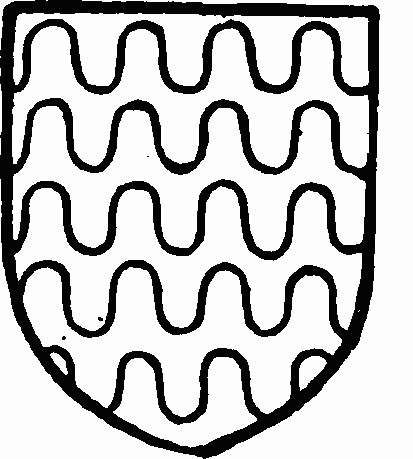
Basset of Wycombe.Barry wavy argent and azure.
In 1327 Edward III granted the manor to his uncle Thomas of Brotherton Earl of Norfolk, (fn. 132) who in 1332 surrendered it to the king and received it again for himself and the heirs of his body, with reversion to the king if he died without such heirs. (fn. 133) This reversion was granted about the same time to William de Bohun (fn. 134) Earl of Northampton, the third son of Humphrey de Bohun Earl of Hereford and Essex. The Earl of Norfolk conveyed his estate in the manor to William de Bohun in 1336 (fn. 135) and died in 1338.
The manor was confirmed to William de Bohun in 1343, (fn. 136) and in 1346 he had licence to settle the manor on himself and his wife Elizabeth. (fn. 137) William died in September 1360 and was succeeded by his son Humphrey Earl of Hereford, and the grant of the manor was confirmed in 1365. (fn. 138) He married Joan daughter of Richard Fitz Alan Earl of Arundel and demised the manor for life to Sir Thomas Baumfeld, who died seised of it July 1375. (fn. 139) Humphrey died on 16 January 1372–3, leaving only two daughters, Eleanor wife of Thomas Duke of Gloucester and Mary wife of Henry of Bolingbroke, afterwards King Henry IV.
Joan the widow of Humphrey seems to have had one third of this manor in dower, and the remaining two thirds went to Eleanor wife of Thomas Duke of Gloucester, (fn. 140) who died seised of them on 3 October 1399. Her son Humphrey having died, her heirs were her daughters Anne wife of Edmund Earl of Stafford, then aged eighteen, Joan, aged fifteen, and Isabel, aged thirteen. (fn. 141) Edmund Earl of Stafford died on 21 July 1403 seised of the two thirds which he had held in right of Anne his wife. (fn. 142)
Joan Countess of Hereford continued to hold her third until her death on 7 April 1419, when it seems to have passed to her other daughter's son, who had ascended the throne as Henry V. (fn. 143) He must also have acquired the other two thirds, and on 9 November 1422 Henry VI granted the manor to his mother Katherine as part of her dower, (fn. 144) and after her death in 1437 (fn. 145) it seems to have been administered as a possession of the Crown. (fn. 146)
It was still in the hands of the Crown in 1586–7, (fn. 147) and in 1603–4 half the site of the manor was granted to Sir Edmund Blount and others. (fn. 148) The remainder of the lands, with view of frankpledge, seem to have passed to Richard Lybbe, who with Anne his wife sold them in 1609 to Francis Castillion. (fn. 149) It is possible that William Hale and others, to whom this lordship and manor were granted in 1610–11, (fn. 150) were trustees for Francis, in any case this manor subsequently followed the descent of the manor of Benham Valence (q.v.) and was held in 1759 by Lord Craven. (fn. 151) Lysons appears to be in error in stating that it was granted in 1565 to John Baptiste Castillion. (fn. 152) It is now held by Mrs. M. H. Best of Donnington.
In the time of Edward the Confessor Ulveva held BAGNOR of the king in alod, and at the time of the Domesday Survey it was held by Humphrey the Chamberlain. (fn. 153) The history of the overlordship is obscure, but in the 13th century it formed part of the fief of the Earl of Gloucester. (fn. 154)
In 1227–8 Henry de Bagnor sold the manor to Richard son of Michael, (fn. 155) and in 1234–5 Ellis de Bagnor conveyed it to William Prior of Poughley Monastery. (fn. 156) This conveyance probably referred to part only of the manor, as the following year Henry de Bagnor conveyed it, or the remainder, to the same prior. (fn. 157) It was held by the priory till its dissolution in 1524. (fn. 158) In 1526 it was granted to Wolsey, (fn. 159) and by him granted that year to the college of Thomas Wolsey at Oxford. (fn. 160) On the attainder of Wolsey it was seized by the king, and by him granted in 1531 to Westminster Abbey. (fn. 161)
In 1542 the manor was transferred to the Dean and Chapter of Westminster, (fn. 162) who received a further grant here in 1559–60, (fn. 163) and it remained their property until purchased in June 1871 by Mr. Head Pottinger Best, at whose death, on 14 December 1887, it passed to his son Mr. Marmaduke Head Best of Donnington Grove, (fn. 164) at whose death, on 3 January 1912, it passed to his widow.
The original township of BENHAM seems to have consisted not only of the present township of Marsh Benham in this parish, but also of the township or tithing of Hoe Benham in the adjoining parish of Welford (q.v.). Certain lands here, granted in 956 by King Edwy to his servant Elfsy, were given by the latter to the abbey of Abingdon, (fn. 165) and the bounds of the township as set out in this charter seem to show that it included land in both parishes. The lands granted to Elfsy seem to have lain in what is now Welford parish, but other lands here were granted about the same time to Wulfric, who held many lands in this part of the county, for we learn that he was deprived of them for some offence, but that they were restored to him by King Edgar in 960. (fn. 166)
In the time of Edward the Confessor the Marsh Benham portion was held in alod of the king by three thegns, who seem to have been the three brothers who held the vill of Westbrook in the adjoining parish of Boxford (q.v.). After the Conquest this land was granted to Humphrey Vis de Lou, (fn. 167) who was holding the adjoining manor of Speen.
According to an inquisition taken in the reign of Henry III, probably about the year 1250, Humphrey Vis de Lou came over with the Conqueror and received from him the manor of Benham, but having slain a certain knight the manor was taken from him by Henry II. Further it is stated that on account of this forfeiture his son Walkelin did not inherit the manor, but the king granted it to Robert of London, who had married Isabel, Walkelin's only daughter, both of whom died without issue, when the manor returned to the king. (fn. 168)
The account thus given cannot be correct, since if Humphrey accompanied the Conqueror he could not have lived to commit a murder in the reign of Henry II. Moreover, it appears that Walkelin did inherit, for between 1100 and 1135 he had a dispute with the abbey of Abingdon as to the vill of Westbrook, (fn. 169) then, as since, a part of the manor of Benham. It was perhaps Walkelin who was the murderer, or the crime may have escaped punishment until the reign of Henry II. At all events, before 1158–9 the manor had become forfeit to the Crown, for in that year the sheriff rendered account of 20s. from the land of William Francis at Benham. (fn. 170) Till 1164–5 the rent of this manor is yearly accounted for by the sheriff, (fn. 171) but in 1166–7 it is entered as from Richard of London, (fn. 172) though in the following year his name does not appear. (fn. 173) In 1173–4 Robert of London is entered as paying the rent, which had risen to 66s. 8d., (fn. 174) and in the following year he paid £6 0s. 12d. towards the aid for marrying the king's daughter. (fn. 175) It seems clear from these entries that the manor was not granted to Robert, but leased to him.
At the time of the Domesday Survey 2 hides were held of Humphrey by Anschetil and 2 by William, (fn. 176) and, as we have seen, William Francis was holding part, at least, of the manor in 1158–9. (fn. 177) Robert of London was tenant in 1166–7, (fn. 178) and William of Rochelle held land here in 1167–8. (fn. 179) In 1194 part, at least, of the manor had been leased by King Richard I to Richard de Camville, (fn. 180) who had already died in the Holy Land, and had been succeeded by his son John. (fn. 181) The lands still appear, however, in his name in 1196–7 and 1198, (fn. 182) and no inquisition was held as to his death until the reign of Henry III. (fn. 183)
John Camville died without issue, and the manor was seized by his uncle Gerard, Richard's elder brother. The king, however, ejected him and granted it to Hugh Wake, (fn. 184) to hold by the serjeanty of being usher of the king's chamber. (fn. 185) Hugh died in or before 1199, and King John granted the custody of his land and heirs to Hugh Nevill, (fn. 186) while in 1205 he gave his widow in marriage to Roger son of Henry. (fn. 187) Hugh Nevill was holding this land, which was valued at 17 librates, between 1210 and 1212. (fn. 188) James Wake, son of Hugh, seems to have inherited the manor and to have married Amy daughter of Peter de Harthelakeston. He died shortly afterwards, leaving an only son Hugh, while the manor passed in dower to his widow, (fn. 189) who subsequently married Richard of Livington. (fn. 190)
Amy died in or before 1243, when her son Hugh did homage for the land. (fn. 191) He died in 1245–6 seised of the manor, which passed to his aunts, Joan de Mumby and Aline Wake. (fn. 192) Joan de Mumby seems to have died soon afterwards, for in 1247 her son John de Gravenel did homage for his share, (fn. 193) but in 1250 the king claimed the manor, and after a trial, which went against the Wakes, it was taken into the king's hands (fn. 194) and granted to William de Valence on 16 August 1251, (fn. 195) when it became known as the manor of BENHAM VALENCE.
In 1275–6 William was holding the manor, then called East Benham, to which was attached the right of gallows and assize of bread and ale. It was stated that the manor formerly did service at the hundred of Faircross, which had been withdrawn by William. (fn. 196) This statement refers probably to the vills of Westbrook and Weston, in Boxford and Welford, which William held of the abbey of Abingdon, and had attached to his manor of Benham, for Benham itself had always been parcel of the hundred of Kintbury. In 1276 the manor was taken into the king's hands because William was in default against Isabel widow of John Gravenel, and Henry de Lacy Earl of Lincoln and Margaret his wife (fn. 197); but he seems to have been in possession again in 1278. (fn. 198)
William died in 1296, (fn. 199) when he was succeeded by his son Aymer de Valence, (fn. 200) who died without issue on 13 June 1324 seised of this manor. (fn. 201)
The king seems to have given the manor to Hugh le Despenser the younger, (fn. 202) but John second Lord Hastings son of Isabel sister of Aymer (fn. 203) claimed it. He died without obtaining it, and his claim passed to his son Lawrence, who in 1325 as Earl of Pembroke had possession of it (fn. 204); he was holding in 1340 (fn. 205) and 1341, (fn. 206) and on 9 September 1342 received licence to grant it for life to William de Hastings, (fn. 207) a bastard. Lawrence died in 1348, (fn. 208) when the manor passed to the above-mentioned William, who died in 1349 seised for life of this manor, (fn. 209) when it passed to Agnes, Lawrence's widow, to hold in dower. On the death of Agnes in 1368 (fn. 210) it passed to her son John Earl of Pembroke.
John died on 16 April 1375 or 1376, (fn. 211) when it passed to his widow Anne, who died seised of it in 1384. (fn. 212) At her death the manor went to her son John, (fn. 213) a minor, who died childless in 1389, aged seventeen. (fn. 214)
The manor seems to have passed at his death to Sir Reginald de Grey, Lord Grey of Ruthin, greatgrandson of John Hastings Earl of Pembroke and Isabel de Valence. (fn. 215) In 1391 Sir Reginald de Grey obtained licence for a settlement of the reversion of the manor, (fn. 216) which was then held in dower by Philippa widow of John Hastings, who had married as her second husband Richard Fitz Alan Earl of Arundel, and afterwards took as her third husband Thomas Poynings Lord St. John of Basing. (fn. 217) At her death on 24 September 1401 (fn. 218) Reginald Lord Grey of Ruthin came into possession, and the settlement projected in 1391 was effected on 20 October 1406. (fn. 219) He seems to have sold the manor soon afterwards to John Roger the elder, who was holding it in 1428, (fn. 220) and conveyed it to his son John Roger the younger in 1428, (fn. 221) who settled it on his wife Elizabeth daughter of John Shotesbroke in 1432. (fn. 222) He was living as late as 1467, (fn. 223) and was succeeded by his son Thomas, who died on 31 August 1471, when his heir was his son Thomas, then aged sixteen and a half years. (fn. 224) Thomas married twice, and in 1480 settled it on his second wife Margaret. He died on 19 January 1488, leaving by his first wife a daughter Elizabeth, then aged thirteen, married to William Essex, but under the settle- ment the manor was held by his widow (fn. 225) till 1497, when Elizabeth came of age. (fn. 226) Margaret, who had married Thomas Fettiplace, (fn. 227) died in 1518, (fn. 228) when the manor passed to Elizabeth.
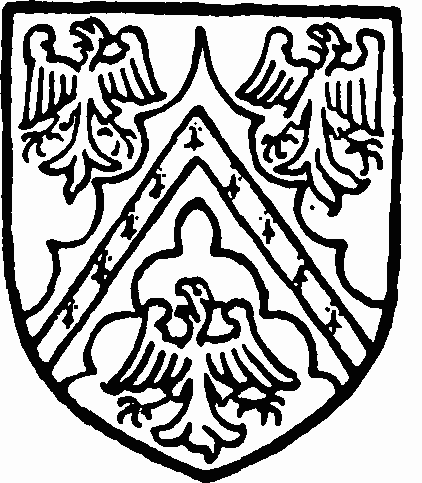
Essex of Lambourn. Azure a cheveron engrailed or and voided ermine between three eagles or.
Sir William Essex of Lam- bourn in 1543, with Thomas his son, exchanged this manor and others adjoining with the king, receiving in exchange the manor of Brightwalton and some others. (fn. 229)
On 25 January 1544 the king appointed Thomas Cawarden, a groom of the Privy Chamber, to be keeper of the mansion and park here, and steward and bailiff of the manor, (fn. 231) and on 30 May 1545 leased the manor to him for twenty-one years. (fn. 232) In spite of this in 1547 Edward VI granted the manor to Thomas Lord Seymour of Sudeley, (fn. 233) who was executed two years later, when his lands were forfeited. In 1552 the same monarch granted the manor to his sister the Lady Elizabeth. (fn. 234) The manor re- mained her property until 1575–6, when she granted it to John Baptiste Castiglion (anglicized into Castillion or Castilion) and Margaret his wife, to be held by them of the manor of East Greenwich in free socage. (fn. 235)
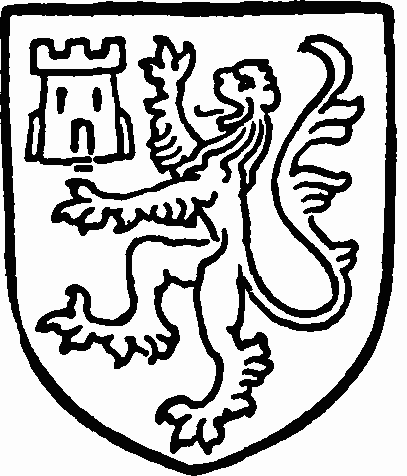
Castillion. Gules a lion argent with a castle or in the quarter. (fn. 230)
John Baptiste Castillion de- scended from the noble family of the Counts Castiglioni, who lived near Mantua in Italy, (fn. 236) and was a son of Peter Castelion of Thuren in Piedmont. He was one of the gentlemen of the Privy Chamber to Queen Elizabeth, and married Margaret daughter and heir of Bartholomew Com- paigne of Florence. He died on 12 February 1597, and was buried at Speen on 17 March, (fn. 237) where a monument was erected to him at the end of the south aisle. (fn. 238) He was succeeded by his eldest son Francis, who married Elizabeth daughter of William St. John. (fn. 239) Francis was knighted at Charterhouse in 1603, (fn. 240) and was living at Benham in 1635, when he addressed a letter from there to Sir John Coke. (fn. 241) He was gentle- man pensioner to James I and M.P. for Great Bedwyn 1596–7, and is said to have sold the manor in 1630 to the trustees of Sir William Craven. (fn. 242) No record of this sale has, however, been found, but in 1630–1 the king granted the lordship and manor, which had been leased to John Baptiste Castillion and Margaret his wife, to Francis Keate and others, (fn. 243) who may have been trustees for Sir William Craven.
Sir William Craven was the eldest son of Sir William Craven, who was Lord Mayor of London in 1611. He distinguished himself as a soldier, and was knighted on 4 March 1626, and on 12 March 1626–7 was raised to the peerage as Lord Craven of Hampstead Marshall. He was created Viscount Craven of Uffington and Earl of Craven on 16 March 1664–5, and died unmarried on 9 April 1697, when the manor passed to William, great-grandson of the late earl's cousin Robert. (fn. 244) The manor has since passed with the Craven family and is held by the present earl.
The sixth Lord Craven built Benham Place and laid out the grounds in 1775 at the request of his wife, and after his death his son sold the house and park to his mother, (fn. 245) who in October 1791 married the Margrave of Anspach. In 1792 the Margrave sold his principality to the King of Prussia, and came with his wife to live at Benham, where he died in 1806. (fn. 246) His widow continued to live at Benham until 1811, when, owing to certain disputes with her neighbours as to a right of way through the park, she left England and went to live in Naples, where she built a villa on 2 acres of land given to her by the King of Naples, and here she died on 13 January 1828, leaving Benham Place to her youngest son, the Hon. Richard Keppel Craven. (fn. 247)
Benham Place and park were sold by the Hon. Richard Keppel Craven to Frederick Reid Orme Villebois, and after his death the estate was sold to the trustees of Sir Richard Sutton, bart. He died on 2 October 1878, when Ben- ham Place passed to his son Sir Richard Francis Sutton, bart., after whose death it passed to trustees, who held it for his son until he attained his majority in April 1912.
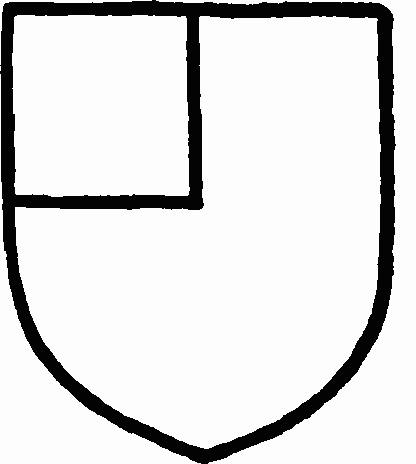
Sutton, baronet. Argemts a quarter sable.
BENHAM LOVELL takes its second name from the family who held it in the 13th century by grant from Henry II or Richard I. The first reference that has been found to a member of the family is in 1198, when land to the value of 100s. was granted to Osbert Lovell in Boxford, a member of the vill of Benham. (fn. 248) He was succeeded by his son William, (fn. 249) who died before 1213, when his widow Emma had not only married Anger the Hunter, but had again become a widow, and paid the king 60 marks and a palfrey to have the custody of the lands and heirs of her deceased husbands, and for permission not to be married again unless she so desired it. (fn. 250) The king granted the custody of her son William in 1216 to his uncle Robert, the king's chaplain, (fn. 251) but a few years later Emma had secured it. (fn. 252) At a later date William obtained possession of his lands, (fn. 253) and was one of the royal huntsmen in 1242, (fn. 254) and he seems to have died in 1275, (fn. 255) when Master Robert le Pestur, the king's serjeant, was given the custody of the manor and heirs during the minority of the latter. (fn. 256) A William Lovell, apparently the son of the former William, was holding the manor in 1284 by serjeanty of keeping a kennel of bloodhounds for the king's use, (fn. 257) though subsequent documents state that it was the manor of Weldon that was held by this tenure. (fn. 258) William Lovell died before 1306, when John Lovell, who appears to have been his son, settled the manor; it was then stated that it was held of the king as half a knight's fee, and by finding one man and one horse with armour in the king's war wherever he may go in England, Wales and Scotland. (fn. 259) In 1313–14 John apparently settled two-thirds of the lands here and the reversion of the third held by Mabel widow of William Lovell on himself and Christina his wife, with remainder to Thomas de Borhunte and his wife Margaret, (fn. 260) who seems to have been John Lovell's daughter, (fn. 261) and on 8 January 1316 licence was granted to him to convey it in trust to Master Richard de Abingdon, the king's clerk. (fn. 262) John died in the same year seised of this manor, (fn. 263) which under the deed of settlement passed to Thomas and Margaret de Borhunte, who in 1334 settled the manor on John, their son, and Mary his wife. (fn. 264) Thomas died in 1340 seised of this manor, which he had held in right of his wife of the king by finding one armed soldier for forty days for the king's war within the kingdom of England, when his heir was said to be his son John, then aged eighteen years. (fn. 265)
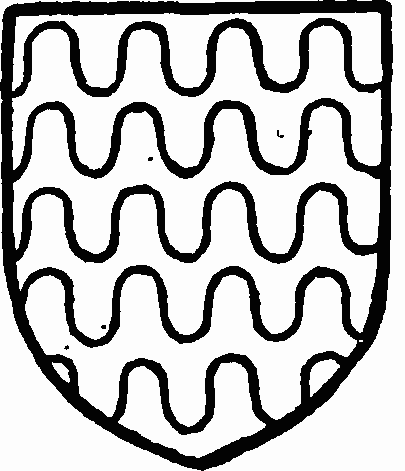
Lovell. Barry wavy or and gules.
The manor was then delivered to Margaret, (fn. 266) who married William Danvers, the king's yeoman, and on 28 October 1341 settled the manor on John de Borhunte and Mary his wife, (fn. 267) and a similar deed of settlement was made in 1344. (fn. 268) William Danvers was holding the manor in 1349, (fn. 269) but in 1354, in spite of the deed of settlement, he sold it to the king. (fn. 270)
In 1360 the manor had been added to the royal manor of Hampstead Marshall, (fn. 271) and in 1361 both manors were delivered to Isabel the king's daughter. (fn. 272) The manors appear to have been conveyed to trustees to hold on behalf of Isabel and her husband, Ingram de Couci Earl of Bedford, and in 1382 the survivors of these trustees had licence to grant this manor to Isabel de Feye, Frenchwoman, one of the maids of the countess, without rent, if she outlived her mistress. (fn. 273)
In 1392 the king granted the manor to Isabel de Feye and her husband Richard Herfeld, in survivorship, without rent, upon surrender of the grant of 1382. (fn. 274) Isabel died before 1408, when the manor of Benham Lovell was confirmed to Richard. (fn. 275) At his death it returned to the king, and the custody was granted in 1443 to the king's serjeant, John Norreys, esquire for the body, (fn. 276) and in 1465 was on lease to John Matthew. (fn. 277) In the same year certain rents from the manor were granted for life to Elizabeth, the king's consort, (fn. 278) while on 31 January 1466 the manor was granted to her. (fn. 279) The rent, however, received from John Norreys for the custody of the manor, together with certain lands here, was in 1471 granted for life to George Duke of Clarence. (fn. 280) The manor of Benham Lovell continued in the hands of the queen until the accession of Henry VII. (fn. 281)
In 1487–8 the custody of the manor was granted to Roger Cheyne, (fn. 282) and in 1509 the manor was granted as dower to Princess Katherine of Aragon (fn. 283) and in like manner to Jane Seymour. (fn. 284) Queen Elizabeth granted it to John Yate, who settled it in 1574 (fn. 285) on his son Edward and Jane his wife, and died seised of it on 26 January 1579. (fn. 286) The following year Edward Yate and Jane his wife sold it to Thomas Parry, (fn. 287) who had already purchased the manor of Welford, and it has since passed with that manor (q.v.). The present owner of the manor is Col. G. B. ArcherHoublon.
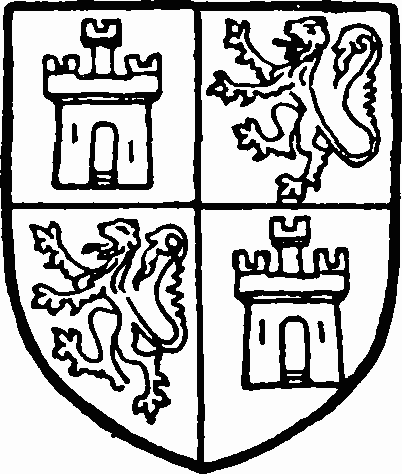
Katherine of Aragon. Castile quartered with Leon.
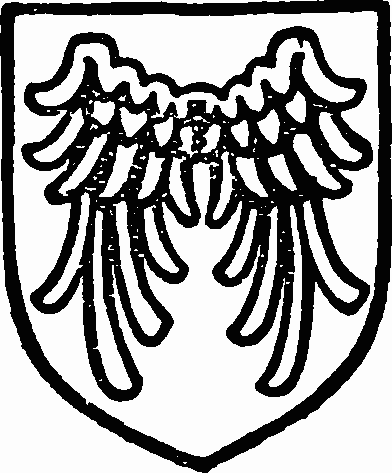
Jane Seymour. Gules a pair of wings or.
Several other estates, sometimes termed manors, were held of the manor of Benham Valence, the most considerable of which was one consisting of a third part of a knight's fee held in 1201 by Ralph son of Mainfelin. (fn. 288) He was holding the manor later in the 13th century. (fn. 289) This estate seems to have passed probably in the 14th or 15th century to Magdalen College, Oxford, (fn. 290) who held it in 1759, when it was described as a manor. (fn. 291)
In 1217 Ralph Musard received seisin of land in Benham, Greenham and Boxford, (fn. 292) and in 1349–50 John de Eastbury and others seem to have granted 144 acres of land in Newbury, Greenham, Benham and Speen to the Prior and convent of Sandleford. (fn. 293) It seems possible that this estate came into the hands of the priory of Poughley, which held land here at the time of its dissolution. These lands were granted in 1526 to Wolsey for his college, (fn. 294) and after the cardinal's death to the abbey of Westminster. (fn. 295)
The Domesday Survey records that the manor of Speen then possessed one mill. (fn. 296) In 1279 there were two fulling-mills, (fn. 297) one of which in 1296 is described as a tanning-mill. (fn. 298) The other mill seems to have gone with the manor of Church Speen. (fn. 299) In 1445 John Rogers bought with the manor a mill called 'Godwyn's Mille.' (fn. 300) There is no mill here at the present day.
At Bagnor there was a mill worth 20s. at the time of the Domesday Survey, (fn. 301) but in or just before 1428 the Prior of Poughley had erected another mill. (fn. 302) One of these, probably that erected in the 15th century, was used as a paper-mill in 1839, (fn. 303) and the cottages there are still known by that name.
A fishery in the river at Speen is frequently mentioned, (fn. 304) and another at Benham, (fn. 305) and fishing at Bagnor is also referred to. (fn. 306)
Churches
The church of ST. MARY THE VIRGIN consists of a chancel, north chapel, north-east vestries and organ chamber, nave of four bays, north aisle, north-west tower and north and south porches.
There has been a church on the site from the 11th century. In 1860 it was almost wholly rebuilt, the original chancel and nave being now the north chapel and aisle, the old narrow south aisle having been destroyed to make way for the new nave. The only old parts of the present building are some of the Purbeck marble circular columns of the nave arcade, the western respond of this arcade, which has plain chamfered edges, and the three westernmost arches, which are two-centred and of two chamfered orders. The other arch of the arcade has only a few old stones. There is also one window in the north aisle of late 14th-century date. It is of three trefoiled ogee lights with flowing tracery in the head. All the modern work is in the Decorated style except the tower, which was rebuilt in 1871 in the Early English style and is externally of three stages. All the walls are of flint with stone dressings and the roofs are tiled.
At the east end of the north chapel is the large altar tomb of John Baptiste Castillion, who died on 12 February 1597; upon the tomb is his recumbent effigy, represented in plate-armour. On the sides and ends of the tomb are shields of Castillion and Compaigne and their connexions. (fn. 307)
On the north wall of the chapel is a monument with the armless effigy of Lady Elizabeth the first wife of Sir Francis son of John Baptiste Castillion, 1603. She wears a farthingale and ornamented gown and a very large head-dress reaching down to the waist. On the centre panel of the tomb is a shield with the arms: 1 and 4 Castillion, 2 and 3 Compaigne impaling (1) St. John, (2) Beauchamp, (3) Ewarby, (4) Carew. There is another shield at the end, but the arms are defaced.
The brass of a priest in mass vestments, John Foster, who died in 1533, which Ashmole records as having been 'near unto the North wall of the chancel,' is lost.
There are also many 18th and 19th-century mural monuments in the aisle and tower, some of considerable size. In the north chapel is an old ironbound chest. Near the Lady Elizabeth monument is a window which contains some fragments of old stained glass with heads and portions of inscriptions. In the gable of the south porch has been set a stone carved with an early consecration cross.
There are seven bells: a ring of six recast by T. Mears in 1809, and a very small bell dated 1800.
The plate consists of a silver cup of good design with the date letter for 1577, a stand paten of 1719, another of 1847 with a cup to match, and a flagon of 1786.
There are four books of registers before 1812, the first a paper volume containing baptisms 1630 to 1698, marriages 1635 to 1698 and burials 1629 to 1703; the second book contains burials from 1678 to 1699, baptisms 1696 to 1698 and marriages 1696 to 1699; the third volume contains all three entries from 1700 to 1749; and the fourth the same from 1750 to 1812.
The church of ST. JOHN, Stockcross, was built in 1839. It consists of a chancel, north vestry and organ chamber, a nave, north and south transepts and a west tower. It is of hard brick with stone dressings, and is designed in a plain Early English style. The east window is a later insertion in the style of the 15th century. The reredos, which is a very elaborate piece of work, is executed in alabaster partly gilded. Two of the south windows of the nave and one in the west wall of the tower contain fragments of what appears to be 17th-century glass. The living is a vicarage in the gift of the Bishop of Oxford.
The church of ST. MARY THE VIRGIN, Speenhamland, consists of a chancel, south organ chamber and vestry, and a large nave in the 14thcentury style which has recently been completed. The living is a vicarage in the gift of the Bishop of Oxford.
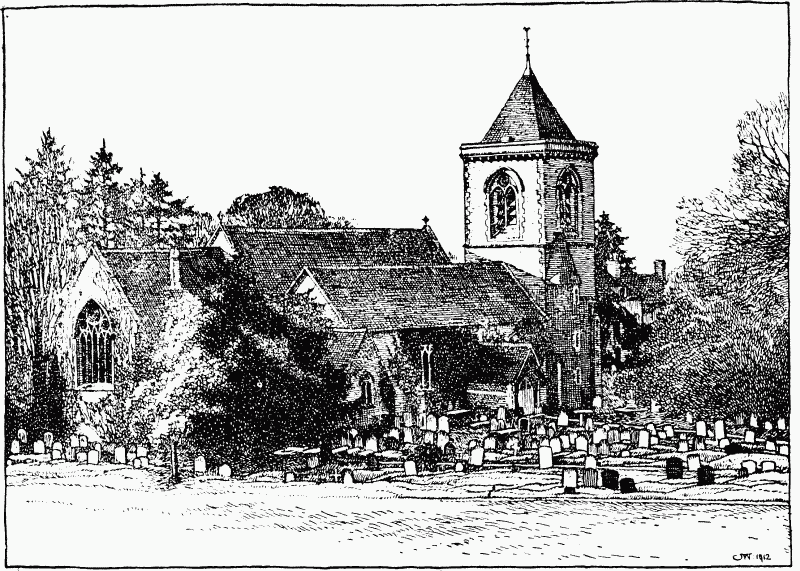
Speen Church From The North-east
Advowson
In 1079 Bernard son of Geoffrey de Neufmarché gave to the church of St. Mary, Aufay, the church of Speen (fn. 308) with half a hide of land. (fn. 309) The church of St. Mary seems, however, to have lost this possession during the next century, for before 1219 William Marshal the elder, Earl of Pembroke, granted the church to the Knights Templars, and this grant was confirmed by his son William Earl of Pembroke between 1225 and 1231, when the advowson is specifically mentioned. (fn. 310) The Templars were suppressed on 27 February 1307, when their property was handed over to the Knights Hospitallers of St. John, who held the advowson of Speen with the rectory until 1380. Pope Urban VI then granted the rectory to the Bishop of Salisbury, leaving, however, the advowson in the hands of the Hospitallers, (fn. 311) which the Hospitallers desired a few years later to sell. In 1388 the prior received licence from the king upon inquisition on 15 October to sell the advowson, worth £20 a year, to the bishop, who was to pay annually to the prior two sums of 36s. 8d. and 30s. respectively. (fn. 312) Some dispute seems to have arisen, and fresh licences were issued on 28 and 29 July 1389 permitting the Hospitallers to alienate the advowson, the bishop paying them a yearly sum of 5 marks. (fn. 313) In spite of this the Hospitallers petitioned Pope Boniface IX towards the end of that year that they might retain the advowson, to which request he acceded in February 1390. His bull appears, however, not to have taken effect, for the bishop presented in 1396, 1418 and 1419, (fn. 314) and in 1434 we find that the bishop held the advowson and paid 5 marks annually to the Hospitallers. (fn. 315) The bishop continued to present till 1819, (fn. 316) when the patronage was transferred to the Bishop of Oxford by an Order in Council in 1852, though owing to a vacancy in that see the Crown presented in 1870. (fn. 317)
Some, if not all, of the tithes seem to have been purchased early in the 17th century by Sir Peter Vanlore, who sold them in 1616 to Anne Howard, widow of Sir William Howard, Lord Howard of Effingham. (fn. 318) The great tithes, as part of the endowments of the Bishop of Salisbury, are now vested in the Ecclesiastical Commissioners, who have out of them augmented the endowments of Stockcross and St. Mary's, Speenhamland. (fn. 319)
An annual rent of 66s. 8d. issuing out of the rectory of Speen was in 1624 sold by William Viscount Wallingford and Elizabeth his wife and others to Christopher Keighley and Robert Ferrest, (fn. 320) and early in the 17th century the rectory was leased to the Castillion family. (fn. 321) The rectory and church lands were sold in 1655, (fn. 322) when they were purchased by Dr. Hugh Barker of Newbury, who married Joan daughter of Edward Goddard of Stargrove, East Woodhay, and left a son Hugh, born at Newbury in 1651. This Hugh married in 1680 Elizabeth daughter of Henry Whitehead of Tytherley, Hants, and after her death in 1697 Hester Heysham. His grandson Hugh married Diana Moor, and died in 1748, and in 1749 his widow married Thomas Wyld. He is described in the Inclosure Act of 1779 as lessee for lives under the Bishop of Salisbury of the great tithes and glebe. He died on 26 May 1789, and his eldest son Thomas died in the following September, when this property passed to his second son, the Rev. George Wyld, rector of Chieveley. He married Mary Dionysia youngest daughter of General Calcraft, and at his death left the property divided among his children. His eldest daughter, Mary Cecil, acquired most of the shares, and in 1860 enfranchised the property, and at her death in 1866 left it to her brother William Thomas Wyld, who died in 1873, leaving it to his second son Captain William Henry Wyld, who sold the estate to the late Sir Richard Francis Sutton, bart., of Benham Place. (fn. 323)
In 1348 William Danvers, lord of the manor of Benham Lovell, gave a sum of money to trustees for five chaplains to sing masses for his soul for three years. (fn. 324)
In the 18th century there were certain houses in Speenhamland, known as Chapel Houses, (fn. 325) which seem to have stood in the open space now known as the Broadway. (fn. 326) It has been thought that on this site a chapel stood in earlier years, (fn. 327) though no evidence of its existence has been found.
Parish of Speen:—
Charities
In 1697 John Webb, by will, gave a rent-charge of £9 out of his estate in Speen to apprentice two boys or girls born in the parish, the trustees being entitled to retain £1 for a collation. The rent-charge is paid by Mrs. Howard Caine, the owner of Deanwood, the property charged. The charity is regulated by a scheme of the Charity Commissioners of 29 March 1867.
Duke of Chandos's Charity.—See under Shawcum-Donnington. The sum of £2 10s. is paid annually, and distributed equally among five poor families.
The Parliamentary returns of 1786 state that William Green left £20 by will to the overseers for the use of the poor. The principal sum appears to have been expended as revenue.
Bread money or poor's land, &c.—The official trustees hold a sum of £260 4s. 5d. consols, arising in part from the sale of the land allotted in 1780 on the inclosure in respect of land originally purchased with gifts of various donors; a legacy of £50 by codicil to will of F. Page, 1832; a legacy of £50 by will of Sarah Page, proved in the P.C.C. 1847, and a legacy of £50 by will of Miss Ann May, proved in the P.C.C. 1852. The annual dividends, amounting to £6 10s., are remitted to the vicar and churchwardens, and are expended in bread, between 170 and 180 gallons being distributed yearly. There is an occasional expenditure in keeping in order certain graves mentioned in Miss May's will.
In 1869 Miss Anna Maria Michell, by will proved at Oxford, bequeathed £200, the interest to be applied for the benefit of the poor. The legacy is now represented by £195 2s. 5d. consols with the official trustees, and the interest, £4 17s. 4d., is applied for the benefit of the coal club.
Sarah Brinton's Charity.—Sarah Brinton, who died in 1865, by her will left £400, the interest to be distributed among the poor. The legacy, less duty and expenses, was invested in £406 16s. 2d. consols with the official trustees, producing £10 3s. 4d. yearly, which sum is, in accordance with a declaration of trust dated 9 November 1865 (enrolled with the Charity Commissioners), divided into three parts, paid respectively to the vicars of Speen, Speenhamland and Stockcross for distribution on Christmas Day in every year amongst four poor individuals or families, regular attendants at church in their respective districts.
In 1870 the Rev. Henry William Majendie, by will proved at Oxford 19 January, bequeathed £200 3 per cent. consols, the annual proceeds to be distributed among six poor men or women regular and deserving communicants at the parish church. The trust fund consists of £202 8s. 6d. consols with the official trustees.
Speen Cottage Hospital and Convalescent Home.— The hospital was erected in 1869 by the Rev. H. W. Majendie on his own land and furnished by subscriptions of the parishioners, and the trusts thereof declared by deed of 17 April 1873 (enrolled). The endowment of the charity now consists of £817 London, Chatham and Dover Railway 4 per cent. arbitration preference stock, producing £36 15s. 3d. a year, and £2,570 Sheffield Corporation redeemable 3 per cent. stock, producing £77 2s. a year, purchased with £2,000 left by the Rev. C. A. Johnson of Enborne in 1892; £500 received under will of Miss Anna Majendie in 1894, and £50 under will of Charles Saunders in 1902. The stock is standing in the names of private trustees.
Church Repair Fund.—In 1894 Miss Anna Eleanor Majendie, by will proved 16 March, left £500 to the Incorporated Society for Building and Repairing Churches. The legacy is represented by £485 8s. 9d. consols in the corporate name of the society, and the annual dividends, amounting to £12 2s. 8d., are applied as directed by the will.
Miss Majendie's bequest for infants' schools.—In 1894 Miss Anna Eleanor Majendie, by will and codicil proved at Oxford on 2 August, gave £200 to the Incorporate National Society in trust for the benefit of the infants' schools, so long as conducted as Voluntary and not as Board schools, and in the latter event to fall into her residuary estate. The legacy, together with a bequest of £300 by the same testatrix for the Stockcross Parochial Schools, was invested in £485 7s. 9d. India 3 per cent. stock in the corporate name of the society. The proportion of the dividends belonging to this charity is £5 16s. 4d.
The Clerk's House Charity.—In 1876 a sum of £200, arising from the sale of a cottage and garden in Speen Lane, which had been formerly appropriated for the benefit of the parish clerk, was invested in the purchase of £11 7s. 1d. annuity (Class B) of the Great Indian Peninsula Railway Company, which, after the deduction of £3 4s. 4d. for a sinking fund, is paid to the clerk under the trusts declared by a deed poll of 24 July 1876.
The Parochial school at Stockcross, comprised in an indenture of 27 October 1838, is regulated by a scheme of the Charity Commissioners of 13 September 1882. The endowment consists of three-fifths of £485 7s. 9d. India 3 per cent. stock in the corporate name of the National Society, representing a legacy of £300 left by Miss Anna Eleanor Majendie. The proportion of the annual dividends, being £8 14s. 8d., is paid to the managers, who also receive the rents of allotment gardens, part of the original school site, producing about £2 11s. 10d. a year.
Liberty of Speenhamland:—
Charity of Sir Thomas Dolman and Sir Joseph Andrews.—In 1707 Sir Thomas Dolman, by deed, gave a rent-charge of 40s., which became vested in Sir Joseph Andrews, who, by his will dated 12 August 1800, gave £100 in lieu of the said rent-charge; this is now represented by £105 consols in the names of private trustees, producing annually £2 12s. 4d., which is distributed in money at Christmas.
The Widows' Pension Charity, which is regulated by scheme of the Charity Commissioners of 17 February 1893, is endowed with 5 a. o r. 28 p. in the parish of Kintbury, known as 'Steward's Land,' and £730 8s. 5d. consols with the official trustees, arising in part from the sale in 1788 of land derived under the will (1664) of Ann Watts and from sales of timber, also from investment of a legacy by will (1859) of Miss Ann Andrews (see below), and from the sale in 1894 of the Widows' House given in 1672 for two widows. The income, amounting to £24 15s. a year, is applied in monthly payments of £1 to each of two widows belonging to Speenhamland.
The Pension Charity of Miss Ann Andrews.— This testatrix, by will proved in London on 19 January 1859, likewise bequeathed £700, the income to be applied towards the maintenance of two poor persons (men or women) inhabitants of the parish of Speen. This legacy was invested in £738 5s. 9d. consols in the names of private trustees; the annual dividends, amounting to £18 9s. 4d., are divided between two poor persons.
The same testatrix left the sum of £900 for the improvement of the stipend of the incumbent of St. Mary's Church, of which £750 was expended in the purchase of land adjoining the church and vicarage, the balance being held by the Governors of Queen Anne's Bounty.
Lecturer's Endowment Fund.—In 1838 Sarah Page, by deed dated 21 February, gave the sum of £1,100 consols as an endowment to provide an afternoon service and lecture in St. Mary's Chapel, the dividends on £100, part thereof, to be applied in defraying the expenses of the church services.
St. Mary's Schools were founded and endowed by Sarah Page by deed of release of 25 April (enrolled) and subsequent deeds, now endowed with the sum of £1,055 15s. 4d. Bank stock, producing yearly £100 11s., and £122 4s. 9d. consols, producing yearly £3 1s. The sums of stock are held by the official trustees.
Gill's Charity.—In 1906 Miss Mary Matilda Gill, by will proved at Oxford on 31 January, gave £500 in trust, the dividends to be given to the coal club. This sum is invested in £533 5s. 7d. India 3 per cent. stock with the official trustees, and the income of £16 is devoted to the benefit of the coal club.
